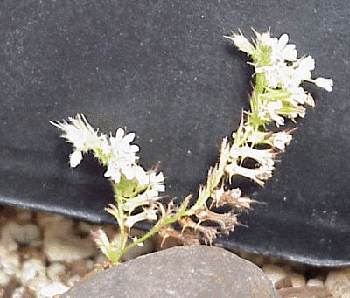|
|
Slender-horned Spineflower
Endangered Species
[Click here for more endangered & threatened species]

Common Name: Slender-horned Spineflower Scientific Name: Dodecahema leptoceras
Status: Endangered
Federal Register: 52 FR 36270 (Sept. 28, 1987)
Comments: As of 2002, there is no federal critical habitat designated for this federally listed member of the Polygonaceae family. It is believed to occur in the Santa Clarita Valley.
The following is from the USDA Forest Service, for the Cleveland National Forest (similar information specific to the Angeles National Forest is not available):
Description: Dodecahema leptoceras is a member of the family Polygonaceae and a low annual plant. It is the only species that have 6 hooked spines near the base of the tube.
Status, Distribution, Population Levels and Trends: Dodecahema leptoceras (DOLE) (then Centrostegia leptoceras) was federally listed as endangered on September 28, 1987 (USFWS 1987) due to a dramatic reduction in range, and immediate and tangible threats to many of its remaining known occurrences. No critical habitat has been designated for this plant. DOLE is State-listed as endangered (and State-ranked G1, S1.1), and is on List 1B of the California Native Plant Society’s list 1B, RED code 3-3-3.
Historic and current Range: At the time of listing, the slender horned spineflower was known from five small and widely scattered occurrences (USFWS 1987). Historically, the species was reported to occur in many of the alluvial systems on the coastal side of the transverse range, in Los Angeles and San Bernardino Counties. The species is now known from nine occurrences from Bee Canyon at the northeast limit of its known range, west to the Santa Ana River Wash in Redlands (which supports a cluster of several sub-populations), and south to Temescal Canyon, Bautista Canyon, and the Vail Lake area of Riverside County, California. Known occurrences on NFS [National Forest Service] lands are at Bautista Canyon on the SBNF, and south of Vail Lake on the CNF. Occurrences at Bee Cn, Big Tujunga Cn, Cajon Creek, Santa Ana River, Tesescal Creek, San Jacinto River, and Dripping Springs occur on alluvial surfaces downstream of NFS lands.
Recovery Plan: No recovery plan has been prepared for Dodehecahema leptoceras.
Suitable Habitat Definition: Slender-horned spineflower occurs on sandy alluvial benches, and floodplain terraces with alluvial scrub vegetation. It also occurs on well-drained slopes in chaparral (near Vail Lake).
Threats: The primary threats to DOLE are loss of habitat through urbanization and flood control projects, and associated hydrological and fluvial geomorphological changes to the alluvial systems that maintain this characteristic habitat type. Off road vehicle activity and invasion of exotic species are also grave threats to some occurrences.
Protection of Occurrences/Degree of Risk to Occurrences on NFS lands: Habitat on the CNF is relatively well protected as it is mostly within the Agua Tibia Wilderness.
Degree to which NFS lands can contribute to recovery: Protection and management on the CNF will contribute to the recovery of the species by promoting the long-term survival of ecologically distinct populations (ie, not alluvial fan). General watershed management of drainages above DOLE occurrences will contribute to recovery by helping to maintain hydrology and fluvial geomorphology with as un-altered dynamics as possible. The Angeles, Cleveland, and San Bernardino National Forests conducted extensive surveys for this species in 1991 so it is unlikely that any additional populations will be discovered on National Forest lands.
Conservation Considerations: Goals and objectives: Manage all on-forest occurrences for long-term survival and recovery. Manage all watersheds above DOLE occurrences to benefit downstream DOLE occurrences wherever possible (e.g. Santa Ana River Watershed Management is not likely to benefit DOLE because of the Seven Oaks Dam).
Literature Cited: US Fish and Wildlife Service. 1987. Endangered and Threatened Wildlife and Plants; Endangered Status For Eriastrum densifolium ssp. sanctorum (Santa Ana River woolly-star) and Centrostegia leptoceras (slender-horned spineflower). Federal Register vol 52, no. 187. Pp. 36265-36270.
Survey Considerations: Diminutive annual herb, subject to wide annual variability as a function of amount and seasonality of rainfall, as well as seed set from previous year(s). Flowers April through June, but most distinct in June and early July after the involucral branches and basal rosette have turned a characteristic dark red color.
Summary of Impacts: Dispersed recreation can lead to trampling of plants. Upstream watershed management, and upstream prescribed fire, can alter downstream hydrology, with adverse (or beneficial) effects.
CE0006: Photo from U.S. Forest Service
The site owner makes no assertions as to ownership of any original copyrights to digitized images. However, these images are intended for Personal or Research use only. Any other kind of use, including but not limited to commercial or scholarly publication in any medium or format, public exhibition, or use online or in a web site, may be subject to additional restrictions including but not limited to the copyrights held by parties other than the site owner. USERS ARE SOLELY RESPONSIBLE for determining the existence of such rights and for obtaining any permissions and/or paying associated fees necessary for the proposed use.